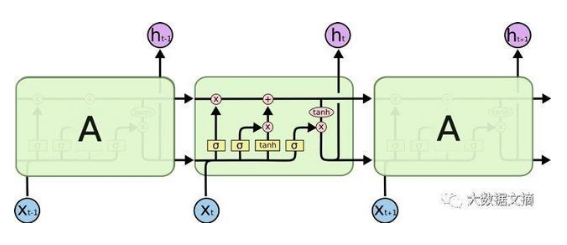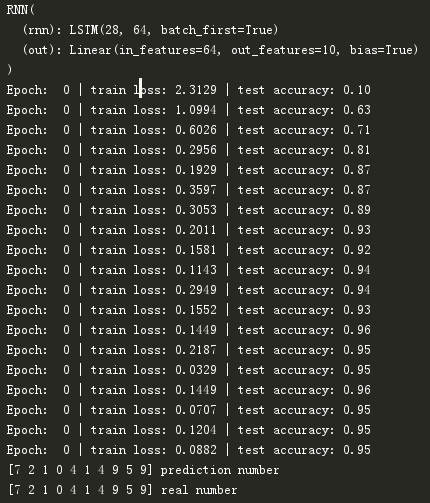RNN和LSTM
一、RNN
全称为Recurrent Neural Network,意为循环神经网络,用于处理序列数据。
序列数据是指在不同时间点上收集到的数据,反映了某一事物、现象等随时间的变化状态或程度。即数据之间有联系。
RNN的特点:1,,层间神经元也有连接(主要为隐层);2,共享参数

其结构如上图所示,数据为顺序处理,在处理长序列数据时,极易导致梯度消失问题。
二、LSTM
LSTM为长短期记忆,是一种变种的RNN,在RNN的基础上引入了细胞状态,根据细胞状态可决定哪些状态应该保留下来,哪些状态应该被遗忘。
LSTM可一定程度上解决梯度消失问题。

由上图可知,在RNN的基础上,增加了一路输入和输出,增加的这一路就是细胞状态。
由上一时刻的输出和当前时刻的输入,经过sigmod函数之后,趋近于0被遗忘的多,趋近于1被遗忘的少。
由上一时刻的输出和当前时刻的输入,经过sigmod函数之后,决定哪些内容应该被记住,被记住的内容并不是上一时刻的输出和当前时刻的输入,而是需要经过tanh函数。
程序:应用LSTM训练mnist数据集
import os
import torch
import torch.nn as nn
import torch.utils.data as Data
from torch.autograd import Variable
import torchvision.datasets as dsets
import matplotlib.pyplot as plt
import torchvision.transforms as transforms # torch.manual_seed(1) # reproducible # Hyper Parameters
EPOCH = 1 # train the training data n times, to save time, we just train 1 epoch
BATCH_SIZE = 64
LR = 0.01 # learning rate
DOWNLOAD_MNIST = False #已下载好数据集,就设置为False,否则为TRUE
TIME_STEP=28 #可理解为输入图像维度
INPUT_SIZE=28 # Mnist digits dataset
if not(os.path.exists('./mnist/')) or not os.listdir('./mnist/'):
# not mnist dir or mnist is empyt dir
DOWNLOAD_MNIST = True train_data = dsets.MNIST(
root='./mnist/',
train=True, # this is training data
transform=transforms.ToTensor(), # Converts a PIL.Image or numpy.ndarray to
# torch.FloatTensor of shape (C x H x W) and normalize in the range [0.0, 1.0]
download=DOWNLOAD_MNIST,
) # plot one example
# print(train_data.train_data.size()) # (60000, 28, 28)
# print(train_data.train_labels.size()) # (60000)
# plt.imshow(train_data.train_data[0].numpy(), cmap='gray')
# plt.title('%i' % train_data.train_labels[0])
# plt.show() # Data Loader for easy mini-batch return in training, the image batch shape will be (50, 1, 28, 28)
train_loader = Data.DataLoader(dataset=train_data, batch_size=BATCH_SIZE, shuffle=True) # pick 2000 samples to speed up testing
test_data = dsets.MNIST(root='./mnist/', train=False,transform=transforms.ToTensor())
test_x = test_data.test_data.type(torch.FloatTensor)[:2000]/255. # shape from (2000, 28, 28) to (2000, 1, 28, 28), value in range(0,1)
test_y = test_data.test_labels.numpy()[:2000] class RNN(nn.Module):
def __init__(self):
super(RNN, self).__init__()
self.rnn = nn.LSTM(
input_size=INPUT_SIZE,
hidden_size=64,
num_layers=1,
batch_first=True
) self.out=nn.Linear(64,10)
def forward(self,x):
r_out,(h_n,h_c)=self.rnn(x,None)
out=self.out(r_out[:,-1,:]) #数据格式为[batch,time_step,input],因此输出参考的是最后时刻的数据
return out rnn=RNN()
print(rnn) # net architecture optimizer = torch.optim.Adam(rnn.parameters(), lr=LR) # optimize all cnn parameters
loss_func = nn.CrossEntropyLoss() # the target label is not one-hotted for epoch in range(EPOCH):
for step, (x, y) in enumerate(train_loader): # gives batch data, normalize x when iterate train_loader
b_x=Variable(x.view(-1,28,28))
b_y=Variable(y)
output = rnn(b_x) # cnn output
loss = loss_func(output, b_y) # cross entropy loss
optimizer.zero_grad() # clear gradients for this training step
loss.backward() # backpropagation, compute gradients
optimizer.step() # apply gradients if step % 50 == 0:
test_output = rnn(test_x)
pred_y = torch.max(test_output, 1)[1].data.numpy().squeeze()
accuracy =float((pred_y==test_y).astype(int).sum())/float(test_y.size)
print('Epoch: ', epoch, '| train loss: %.4f' % loss.data.numpy(), '| test accuracy: %.2f' % accuracy) # print 10 predictions from test data
test_output = rnn(test_x[:10].view(-1,28,28))
pred_y = torch.max(test_output, 1)[1].data.numpy().squeeze()
print(pred_y, 'prediction number')
print(test_y[:10], 'real number')
运行结果为:

RNN和LSTM的更多相关文章
- RNN and LSTM saliency Predection Scene Label
http://handong1587.github.io/deep_learning/2015/10/09/rnn-and-lstm.html //RNN and LSTM http://hando ...
- RNN 与 LSTM 的应用
之前已经介绍过关于 Recurrent Neural Nnetwork 与 Long Short-Trem Memory 的网络结构与参数求解算法( 递归神经网络(Recurrent Neural N ...
- Naive RNN vs LSTM vs GRU
0 Recurrent Neural Network 1 Naive RNN 2 LSTM peephole Naive RNN vs LSTM 记忆更新部分的操作,Naive RNN为乘法,LSTM ...
- TensorFlow之RNN:堆叠RNN、LSTM、GRU及双向LSTM
RNN(Recurrent Neural Networks,循环神经网络)是一种具有短期记忆能力的神经网络模型,可以处理任意长度的序列,在自然语言处理中的应用非常广泛,比如机器翻译.文本生成.问答系统 ...
- 浅谈RNN、LSTM + Kreas实现及应用
本文主要针对RNN与LSTM的结构及其原理进行详细的介绍,了解什么是RNN,RNN的1对N.N对1的结构,什么是LSTM,以及LSTM中的三门(input.ouput.forget),后续将利用深度学 ...
- 3. RNN神经网络-LSTM模型结构
1. RNN神经网络模型原理 2. RNN神经网络模型的不同结构 3. RNN神经网络-LSTM模型结构 1. 前言 之前我们对RNN模型做了总结.由于RNN也有梯度消失的问题,因此很难处理长序列的数 ...
- RNN以及LSTM的介绍和公式梳理
前言 好久没用正儿八经地写博客了,csdn居然也有了markdown的编辑器了,最近花了不少时间看RNN以及LSTM的论文,在组内『夜校』分享过了,再在这里总结一下发出来吧,按照我讲解的思路,理解RN ...
- 深度学习:浅谈RNN、LSTM+Kreas实现与应用
主要针对RNN与LSTM的结构及其原理进行详细的介绍,了解什么是RNN,RNN的1对N.N对1的结构,什么是LSTM,以及LSTM中的三门(input.ouput.forget),后续将利用深度学习框 ...
- 利用RNN(lstm)生成文本【转】
本文转载自:https://www.jianshu.com/p/1a4f7f5b05ae 致谢以及参考 最近在做序列化标注项目,试着理解rnn的设计结构以及tensorflow中的具体实现方法.在知乎 ...
随机推荐
- MATLAB GUI界面设计------“轴”组件配置
1> Fontsize 10 %字体大小 2> FontUnits normalized %采用相对度量单位,缩放时保持 ...
- Python-异常处理-66
异常和错误 # 1/0 # name # 2+'3' # [][3] #{}['k'] try: ') # 1/0 ') # name # 2+'3' # [][3] # {}['k'] ret = ...
- Linux下网络配置与修改Centos7为列
一.基础知识 手动绑定: 命令 一般是临时的修改,重启后失效,如:ifconfig.route.ip addr等. 修改配置文件 修改文件配置,永久有效,但是可能不能立即生效,需要重启服务 (serv ...
- Ubuntu本地文件上传至HDFS文件系统出现的乱码问题及解决方案
1.问题来源及原因 用shell命令上传到HDFS中之后出现中文乱码,在shell命令窗口查看如图: 在eclipse中的文件HDFS查看工具查看如图: 原因:上传至HDFS文件系统的文本文件(这里是 ...
- SSM项目使用GoEasy 获取客户端上下线实时状态变化及在线客户列表
一.背景 上篇SSM项目使用GoEasy 实现web消息推送服务是GoEasy的一个用途,今天我们来看GoEasy的第二个用途:订阅客户端上下线实时状态变化.获取当前在线客户数量和在线客户列表.截止我 ...
- git常用命令二、:git stash
Git stash 储藏工作现场(当你不得不新建分支,或者切换分支,但是当前工作区的修改并不想提交) git stash Saved working directory and index state ...
- 百度编辑器html网页显示
$(function () { var ue = UE.getEditor('content',{ serverUrl:'{:\\think\\Url::build("Ueditor/ind ...
- IFE第一天
我也不知道自己到底能坚持多少天,希望66天可以坚持下来,flag在此. 第一天的知识大概就是了解一些基本概念. Web: 基于HTTP协议,利用浏览器访问网站. HTML 大概就是告诉浏览器我有一个什 ...
- 简单 php 代码跟踪调试实现
简单 php 代码跟踪调试实现 debug_backtrace:生成回溯 debug_print_backtrace:打印回溯 1. debug_backtrace ($options = DEBUG ...
- Linux内核模块编程——Hello World模块
Linux内核模块编程 编程环境 Ubuntu 16.04 LTS 什么是模块 内核模块的全称是动态可加载内核模块(Loadable Kernel Modul,KLM),可以动态载入内核,让它成为内核 ...
